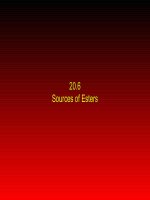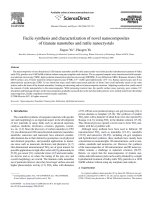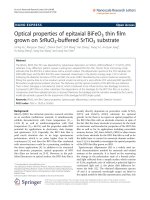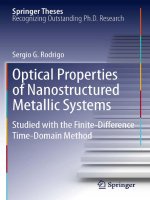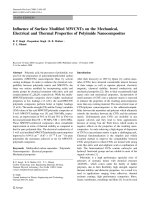Optical limiting properties of novel nanocomposites
Bạn đang xem bản rút gọn của tài liệu. Xem và tải ngay bản đầy đủ của tài liệu tại đây (3.87 MB, 156 trang )
OPTICAL LIMITING PROPERTIES OF NOVEL
NANOCOMPOSITES
VENKATESH MAMIDALA
NATIONAL UNIVERSITY OF SINGAPORE
2012
OPTICAL LIMITING PROPERTIES OF NOVEL
NANOCOMPOSITES
VENKATESH MAMIDALA
(M. Sc. University of Hyderabad, INDIA)
A THESIS SUBMITTED
FOR THE DEGREE OF DOCTOR OF PHILOSOPHY
DEPARTMENT OF PHYSICS
NATIONAL UNIVERSITY OF SINGAPORE
2012
Acknowledgements
i
Acknowledgements
The work presented in this thesis would not have been possible without my close
association with many people who were always there when I needed them the most. I take
this opportunity to acknowledge them and extend my sincere gratitude for helping me
make this Ph.D. thesis a possibility.
I wish to express my sincere gratitude to Prof. Ji Wei, my thesis advisor, for his
invaluable encouragement and guidance.
I would like to express my sincerest appreciation to Dr. Jiang Jiang and Prof. Jackie Y.
Ying from Institute of Bioengineering and Nanotechnology; Dr. Anupam Midya and Prof.
Loh Kian Ping from Department of Chemistry, for providing the precious nanocomposites.
Special thanks to our collaborators, Dr. Polavarapu Lakshminarayana and Prof. Xu
Qing-Hua from Department of Chemistry for their help in the sample preparation and
allowing me to do transient absorption studies in their laboratory.
I express my heart-felt gratitude to Dr. Venkatram Nalla for his kind support and
fruitful discussions during my research work.
I would also like to thank all the current and past members of the Femtosecond Laser
Spectroscopy Lab: Dr. Hendry Izaac Elim, Dr. Gu Bing, Dr. Xing Guichuan, Dr. Qu
Yingli, Mr. Mohan Singh Dhoni, Mr. Yang Hongzhi and Ms. Wang Qian for
accommodating me and creating an excellent atmosphere for research and learning.
Furthermore, I would like to thank my friends, Mr. Sujit, Mr. Lakshmi, Mr. Kiran, Mr.
Suresh, Mr. Vinayak, Mr. Naresh, Mr. Ravi, Mr. Rajesh Tamang, Ms. Shreya, Mr. Satya,
Mr. Prashant, Mr. Ajeesh, Mr .Sudheer, Mr. Mallikarjun, Mr. Christie, Mr. Saran Kumar,
Acknowledgements
ii
Ms. Nithya, Mr. Nakul Saxena and Ms. Anbharasi for their support and making my days
in NUS always enjoyable. Special thanks to Ms. Nithya for examining and correcting my
thesis.
The National University of Singapore (NUS) is gratefully acknowledged for
supporting this project and my Graduate Research Scholarship. I would also like to thank
the Department of Physics and its academic, technical and administrative staff for the
kind support and assistance since the start of my doctoral studies at NUS.
Finally, last but not the least I would like to thank my parents for their affectionate
support and encouragement throughout my graduate studies.
Table of Contents
iii
Table of Contents
Acknowledgments i
Table of Contents iii
Summary vi
List of Tables ix
List of Figures x
List of Publications xiv
Chapter 1 Introduction 1
1.1 Introduction to Optical Limiting 1
1.2 Mechanisms for Optical Limiting 3
1.2.1 Nonlinear Absorption 3
1.2.1.1 Multi-Photon Absorption 4
1.2.1.2 Excited State Absorption 6
1.2.1.3 Free-Carrier Absorption 9
1.2.2 Nonlinear Refraction 10
1.2.2.1 Self-focusing/defocusing of Electronic Nature 11
1.2.2.2 Self-focusing/defocusing of Thermal Nature 13
1.2.3 Nonlinear Scattering 15
1.3 Materials for Optical Limiting 17
1.3.1 Semiconductor Nanomaterials 18
1.3.2 Metal Nanomaterials 19
1.3.3 Carbon-based Nanomaterials 21
1.3.4 Nanocomposite Materials 23
1.4 Objectives and Scope of the Thesis 26
1.5 Layout of the Thesis 27
References 29
Chapter 2 Experimental Techniques 42
Table of Contents
iv
2.1 Z-scan Technique 42
2.2 Z-scan Data Analysis 43
2.3 Optical Limiting Characterization Technique 49
2.4 Femtosecond Transient Absorption Spectroscopy (Pump-Probe Technique) 50
References 53
Chapter 3 Surface Plasmon Enhanced Third-Order Nonlinear Optical
Effects in Ag-Fe
3
O
4
Nanocomposites 56
3.1 Introduction 56
3.2 Discrete Dipole Approximation Model 58
3.3 Synthesis 61
3.4 Results 62
3.4.1 Z-scans with Femtosecond Laser Pulses 63
3.4.2 Theoretical Analysis 67
3.4.3 Discussion 73
3.5 Conclusion 75
References 76
Chapter 4 Surface Plasmon Enhanced Optical Limiting Properties of
Ag-Fe
3
O
4
Nanocomposites 82
4.1 Introduction 82
4.2 Results and Discussion 84
4.2.1 Optical Limiting with Nanosecond Laser Pulses 86
4.2.2 Optical Limiting with Femtosecond Laser Pulses 89
4.3 Conclusion 91
4.4 References 92
Chapter 5 Optical Limiting Properties of Fluorene-Thiophene-
Benzothiadazole Polymer Functionalized Graphene Sheets 96
5.1 Introduction 96
5.2 Sample Preparation 97
Table of Contents
v
5.2.1 Synthesis and Characterization 97
5.3 Results and Discussion 102
5.3.1 Optical Limiting Measurements 108
5.3.2 Nonlinear Scattering Measurements 109
5.4 Conclusion 112
References 113
Chapter 6 Enhanced Optical Limiting Properties of Donor-Acceptor
Ionic Complexes via Photoinduced Energy Transfer 117
6.1 Introduction 117
6.2 Synthesis 119
6.3 Results and Discussion 120
6.4 Conclusion 130
References 132
Chapter 7 Conclusions 136
Summary
vi
Summary
The protection of optical sensors or human eyes from intense laser radiation is highly
sought as the laser technology is growing tremendously with the development of highly
powerful pulsed lasers. To meet such a demand, a vast amount of research efforts and
advances have been made in a subfield of nonlinear optics, often called as optical limiting,
in which the light absorption and/or light scattering of a material increases with the
intensity of incident laser pulses. Most of the works have been carried out towards ideal
optical limiting materials by exploiting the underlying mechanisms including
multi-photon absorption, reverse saturable absorption, nonlinear scattering and nonlinear
refraction. However, the lack of strong optical limiting performers has hindered practical
applications. This dissertation presents detailed optical limiting investigations performed
on novel nanocomposites such as Ag-Fe
3
O
4
nanocomposites and graphene oxide
nanocomposites.
First, we have investigated the effects of attached silver (Ag) particles on the
nonlinear optical properties of Fe
3
O
4
nanocubes. In particular, the Ag-size dependence of
both two-photon absorption (TPA) and nonlinear refractive index (NLR) of Fe
3
O
4
nanocubes was measured experimentally by using femtosecond Z-scan technique and
compared with the theoretical calculated enhancement factor through discrete dipole
approximation (DDA) modeling. As compared to pure Fe
3
O
4
nanocube, the TPA and NLR
cross-section of Ag-particle-attached Fe
3
O
4
nanocube were increased by several folds at
light frequencies far below the surface plasmon resonance of Ag nanoparticle, with
precise values depending on the size of Ag nanoparticle. These enhanced values were in
Summary
vii
agreement with the theoretically calculated enhancement by DDA modeling, which
revealed that the local electric field induced by the metal nanoparticle should play a
crucial role in the observed enhancement. Subsequently, we examined the optical limiting
properties of these Ag-Fe
3
O
4
nanocomposites for both femtosecond and nanosecond laser
pulses. With these nanocomposites, we demonstrated that broad temporal optical limiting
could be accomplished with low limiting threshold. Due to the presence of Ag
nanoparticles, nonlinear scattering gave rise to enhanced optical limiting responses to 532
nm nanosecond laser pulses, with a limiting threshold comparable to carbon nanotubes,
which is known as a benchmark optical limiter. Exposure to 780 nm femtosecond laser
pulses, resulted in superior limiting responses with a limiting threshold as low as 0.04
J/cm
2
using enhanced TPA. The limiting threshold could be further reduced by increasing
Ag particle size through plasmon enhancement.
Secondly, with nanosecond laser pulses at 532 nm wavelength, we have measured the
optical limiting properties of reduced graphene oxide-polymer composite solutions.
Fluence-dependent transmittance measurements showed that the limiting threshold values
(0.93 J/cm
2
and 1.12 J/cm
2
) of these reduced graphene oxide-polymer composites were
better than that of carbon nanotubes (3.6 J/cm
2
). Nonlinear scattering experiments
suggested that nonlinear scattering should play an important role in the observed optical
limiting effects.
Lastly, we have shown a simple strategy to enhance optical limiting responses in
donor-acceptor complexes by utilizing ionic interactions between donor and acceptor
materials. The donor-acceptor complexes were prepared simply by mixing oppositely
Summary
viii
charged donors and acceptors, which offers great advantages over covalent
functionalization where a complex chemistry is required for synthesizing such complexes.
Optical limiting properties of donor-acceptor ionic complexes in aqueous solution were
studied with 7 ns laser pulses at 532 nm and the optical limiting response of negatively
charged gold nanoparticles or graphene oxide (Acceptor) was shown to be improved
significantly when they were mixed with water-soluble, positively-charged porphyrin
(Donor) derivative. In contrast, no enhancement was observed when mixed with
negatively-charged porphyrin. Time correlated single photon counting measurements
showed shortening of porphyrin emission lifetime when positively-charged porphyrin was
bound to negatively-charged gold nanoparticles or graphene oxide due to energy or/and
electron transfer. Transient absorption measurements of the donor-acceptor complexes
confirmed that the addition of energy transfer pathway should be responsible for
excited-state deactivation, which results in the observed enhancement. Fluence- and
angle-dependent scattering measurements suggested that the enhanced nonlinear
scattering due to faster nonradiative decay should be a major contributor the enhanced
optical limiting properties. These findings strongly support a potential application of
donor-acceptor complexes for all laser protection devices.
List of Tables
ix
List of Tables
Table 3.1. Effective NLR and TPA cross-sections measured at wavelength of 780 nm and
light irradiance of 100 GW/cm
2
.
Table 3.2. Enhancement factor in the effective TPA cross-section (
2
) at 780 nm.
Table 3.3. Enhancement factor in the effective NLR cross-section (
n
) at 780 nm.
List of Figures
x
List of Figures
Figure 1.1. Schematic representation of the behavior of an ideal optical limiter.
Figure 1.2. Schematic energy level diagram for MPA process.
Figure 1.3. Schematic energy level diagram for the excited state absorption.
Figure 1.4. Free-carrier absorption in semiconductor.
Figure 1.5. (a) Typical optical configuration for a self-defocusing limiter. (b) Typical
optical configuration for a self-focusing limiter.
Figure 2.1. Z-scan experimental setup in which the energy ratio D
2
/D
1
is recorded as a
function of the sample position z.
Figure 2.2. Experimental setup for optical limiting (or fluence-dependent transmittance)
and nonlinear scattering measurements. (P
1
and P
2
are polarizers)
Figure 2.3. Schematic diagram of femtosecond transient absorption spectroscopy. M -
mirror, BS - beam splitter, C - chopper, L - lens, S - sample, MC -
monochromator and D - detector.
Figure 3.1. (a) Low-resolution and (b) high-resolution TEM images of Ag-Fe
3
O
4
nanocomposites. (c) Schematic of an Ag-Fe
3
O
4
nanocomposite with capping
layer.
Figure 3.2. Absorption spectra of Ag-Fe
3
O
4
nanocomposites and Fe
3
O
4
nanocubes in
toluene solution.
Figure 3.3. Open-aperture Z-scans of (a) Fe
3
O
4
nanocubes and (b) Fe
3
O
4
-Ag (7 nm)
nanocomposites in toluene with the theoretical fittings (solid lines). The
insets show the measured effective TPA coefficients as a function of the
input light irradiance. The linear transmittance of all the solutions were
adjusted to 60%.
Figure 3.4. Closed-aperture Z-scans of (a) Fe
3
O
4
nanocubes and (b) Fe
3
O
4
-Ag (7 nm)
nanocomposites in toluene with the theoretical fittings (solid lines). The
insets show the measured effective NLR index as a function of the input
light irradiance. The linear transmittance of all the solutions were adjusted to
60%.
Figure 3.5. Comparison of normalized absorption efficiency factor (Q
abs
, black lines) and
List of Figures
xi
normalized linear absorption coefficient (α, red lines) of Ag particles with
diameter (a) 3.5 nm, (b) 7 nm, and (c) 10 nm.
Figure 3.6. (a)
3
eff
E
for Ag particle diameter of 3.5 nm, 7 nm, and 10 nm in toluene
is plotted as a function of distance from the particle surface at wavelength of
780 nm. (b)
3
eff
E
on the surface of Ag particle (diameter of 7 nm) in
toluene is plotted as a function of wavelength.
Figure 3.7. Experimental and theoretical enhancement factors of TPA and NLR cross
sections at 780 nm wavelength.
Figure 4.1. TEM image of Ag(7 nm)-Fe
3
O
4
nanocomposites.
Figure 4.2. (a) Absorption spectra of Ag(7 nm)-Fe
3
O
4
nanocomposites and Fe
3
O
4
nanocubes in toluene. The difference between the two spectra is shown by
the line. The inset displays the size distributions of Fe
3
O
4
nanocubes and Ag
nanoparticles. (b) Powder XRD pattern of Ag-Fe
3
O
4
nanocomposites.
Figure 4.3. Fluence-dependent transmittance measured for Ag(7 nm)-Fe
3
O
4
NCs, Ag(10
nm)-Fe
3
O
4
NCs and Fe
3
O
4
nanocubes in toluene solution and carbon
nanotubes in water using 7 ns laser pulses at 532 nm. The linear transmittance
of all the solutions were adjusted to 60%.
Figure 4.4. Nonlinear scattering signals measured for the Ag(7 nm)-Fe
3
O
4
NCs, Fe
3
O
4
nanocubes in toluene solution and carbon nanotubes in water using 532 nm,
7 ns laser pulses at an angle of 45
O
.
Figure 4.5. Nonlinear scattering signals measured for the Ag(7 nm)-Fe
3
O
4
NCs in toluene
solution using 532 nm, 7 ns laser pulses at an angle of 20
O
, 45
O
and 135
O
.
Figure 4.6. Polar plot of the scattered signal measured for Ag(7 nm)-Fe
3
O
4
NCs and
Fe
3
O
4
nanocubes in toluene solution and carbon nanotubes in water using
532 nm, 7 ns laser pulses at various angles with an input energy of 900 J.
Figure 4.7. Polar plot of the scattered signal measured for Ag(7 nm)-Fe
3
O
4
NCs in
toluene solution using 532 nm, 7 ns laser pulses at various angles with four
different input energies.
Figure 4.8. Optical Limiting response of Fe
3
O
4
nanocubes, Ag(7nm)-Fe
3
O
4
NCs and
Ag(10nm)-Fe
3
O
4
NCs in toluene measured using 330 fs laser pulses at 780
nm. The linear transmittance of all the solutions were adjusted to 60%.
List of Figures
xii
Figure 5.1. XPS survey scan of rGO–PhBr. The presence of the Br 3p peak proves the
successful grafting of the bromophenyl group.
Figure 5.2. (a) AFM images of GO. (b) Section analysis shows the sheet height of 0.9 nm.
(c) Digital image of (i) Polymer 1, (ii) G-Polymer 1, (iii) rGO, (iv)
G-Polymer 2, and (v) Polymer 2 dispersions in chloroform.
Figure 5.3. UV-visible spectra of (a) G-Polymer 1, Polymer 1 in toluene and rGO-PhBr
in DMF, (b) G-Polymer 2, Polymer 2 in toluene and rGO-PhBr in DMF.
Figure 5.4. Fluorescence spectra of (a) G-Polymer 1 and Polymer 1 excited at 450 nm (b)
G-Polymer 2 and Polymer 2 excited at 532 nm in toluene. The fluorescence
is effectively quenched by graphene.
Figure 5.5. FTIR spectra of GO, rGO-PhBr, G-Polymer 1 and G-Polymer 2.
Figure 5.6. (a) TEM image of G-Polymer. (b) Magnified view of the rectangle part of the
single sheet in (a). Confocal fluorescence images of polymer coated
graphene sheets: (c) G-Polymer 1 and (d) G-Polymer 2.
Figure 5.7. AFM images of Polymer 2 coated graphene, grown from micrometer-sized
rGO on SiO
2
substrate. (a) Magnified image after a growth time of 20 h, top
view showing polymer grains on rGO. (b) image of G-Polymer 2 on rGO
after 20h growth time, indicating clear difference between G-Polymer 2 and
SiO
2
, (c) Standard image of G-polymer 2 after growth time of 60 h.
G-polymer 2 thickness increases to 6.7 nm after 60 h, which has been shown
in left part of (c).
Figure 5.8. Fluence-dependent transmittance of (a) CNT, rGO in water and Polymer 1
and G-Polymer 1 in toluene; and (b) CNT, rGO in water and Polymer 2 and
G-Polymer 2 in toluene measured using 7 ns pulses at 532 nm. The linear
transmittances of all the solutions were adjusted to 65%.
Figure 5.9. Nonlinear scattering signals (at an angle of 10
O
to the propagation axis of the
transmitted laser beam) of (a) CNT, rGO in water and Polymer 1 and
G-Polymer 1 in toluene; and (b) CNT, rGO in water and Polymer 2 and
G-Polymer 2 in toluene measured using 7 ns pulses at 532 nm. The linear
transmittances of all the solutions were adjusted to 65%.
Figure 6.1. (a) Chemical structure of TMPyP (P
+
). (b) Chemical structure of T790 (P
-
). (c)
Schematic representation of Au+P
+
complex. (d) Schematic representation of
GO+P
+
complex.
Figure 6.2. (Left) TEM image of Au NPs and (Right) AFM image of GO.
5 nm
List of Figures
xiii
Figure 6.3. UV-Vis-NIR spectra of (a) P
+
, P
-
, Au, Au+P
+
and Au+P
-
; and (b) P
+
, P
-
, GO,
GO+P
+
and GO+P
-
complexes in water solution.
Figure 6.4. Fluorescence spectra of (a) P
+
, P
-
, Au+P
+
and Au+P
-
; and (b) P
+
, P
-
, GO+P
+
and GO+P
-
complexes in water solution.
Figure 6.5. Fluorescence decays of (a) P
+
, Au+P
+
and GO+P
+
; and (b) P
-
, Au+P
-
and
GO+P
-
complexes in water solution. The instrument response function (IRF)
is shown above as unlabelled violet color trace.
Figure 6.6. (Top) Transient absorption spectra of P
+
, Au+P
+
and GO+P
+
in water solution
collected at 1ns after 400 nm femtosecond laser excitation.(Bottom) Decay
dynamics of P
+
, Au+P
+
and GO+P
+
at a probe wavelength of 465 nm.
Figure 6.7. Fluence-dependent transmittance measured for (a) Au, P
+
, P
-
, Au+P
+
and
Au+P
-
; and (b) GO, P
+
, P
-
, GO+P
+
and GO+P
-
complexes in water solution.
The linear transmittance of all the solutions were adjusted to 65%.
Figure 6.8. Scattered light measured for (a) Au, P
+
, P
-
, Au+P
+
and Au+P
-
; and (b) GO, P
+
,
P
-
, GO+P
+
and GO+P
-
complexes in water solution at an angle of 20
O
. Inset
of (a) and (b) are the polar plots of the scattering signal as a function of the
angular position of the detector. The linear transmittance of all the solutions
were adjusted to 65%.
List of Publications
xiv
List of Publications
International Journals:
1. "Synthesis and Superior Optical-Limiting Properties of Fluorene-
Thiophene-Benzothiadazole Polymer-Functionalized Graphene Sheets" Anupam
Midya,
Venkatesh Mamidala, Jia-Xiang Yang, Priscilla Kai Lian Ang, Zhi-kuan
Chen, Wei Ji, and Kian Ping Loh, Small, 6, 2292–2300 (2010).
2. "Enhanced Nonlinear Optical Responses in Donor-Acceptor Ionic Complexes via
Photo Induced Energy Transfer" Venkatesh Mamidala, Lakshminarayana Polavarapu,
Janardhan Balapanuru, Kian Ping Loh, Qing-Hua Xu, and Wei Ji, Optics Express 18,
25928-25935 (2010).
3. "Surface Plasmon Enhanced Third-Order Nonlinear Optical Effects in Ag-Fe
3
O
4
Nanocomposites" Venkatesh Mamidala, Guichuan Xing, and Wei Ji, The Journal of
Physical Chemistry C 114, 22466-22471 (2010).
4. "Large Femtosecond Two-Photon Absorption Cross-Sections of Fullerosome Vesicle
Nanostructures Derived from Highly Photoresponsive Amphiphilic C
60
-Light
Harvesting Fluorene Dyad" Min Wang, Venkatram Nalla, Seaho Jeon, Venkatesh
Mamidala, Wei Ji, Loon-Seng Tan, Thomas Cooper, and Long Y. Chiang, The
Journal of Physical Chemistry C 115 18552–18559 (2011).
5. "Huge Enhancement of Optical Nonlinearity in Coupled Metal Nanoparticles Induced
By Conjugated Polymers" Lakshminarayana Polavarapu, Venkatesh Mamidala,
Zhenping Guan, Wei Ji, and Qing-Hua Xu, Applied Physics Letters 100, 023106
(2012).
List of Publications
xv
6. "One Pot Synthesis of CdS Semiconductor Nanorods-Benzothiaziazole Copolymer
Nanocomposites and Their Nonlinear Optical Reponses" Pradipta Sankar Maiti,
Venkatesh Mamidala, Venkartam Nalla, Wei Ji, and Suresh Valiyaveettil (Manuscript
in Preparation).
7. "Nonlinear Absorption and Photoconducting Properties of Anisotropic CdS-AginS
2
Nanocrystals Grown in Conducting Polymers" Venkatesh Mamidala, Pradipta
Sankar Maiti, Venkartam Nalla, Suresh Valiyaveettil, and Wei Ji (Manuscript in
Preparation).
Conference Presentations:
1. "Surface Plasmon Enhanced Non-linear Optical Properties of
Ag-Fe
3
O
4
Nanocomposites" Venkatesh Mamidala, Jiang Jiang, Jacky Y. Ying, and
Wei Ji, 4
th
MRS-S Conference on Advanced Materials, IMRE, Singapore, March,
17-19, 2010.
2. "Superior Optical Limiting Properties of Fluorene-Thiophene-Benzothiadazole
Polymer Functionalized Graphene Sheets" Venkatesh Mamidala, Anupam Midya
,
Jia-Xiang Yang, Priscilla Kai Lian Ang, Zhi-kuan Che, Kian Ping Loh, and Wei Ji,
Physics Graduate Congress-2010, Department of Physics, National University of
Singapore.
3. "Enhanced Optical Limiting in Donor-Acceptor Ionic Complexes via Photoinduced
Energy Transfer and Scattering" Venkatesh Mamidala,
Lakshminarayana
Polavarapu,
Janardhan Balapanuru, Kian Ping Loh,
Qing Hua Xu, and Wei Ji,
AsiaNANO 2010, Tokyo, Japan, November 1- 3, 2010.
List of Publications
xvi
4. "High Two-Photon Absorption and Light-Transmittance Reduction Efficiency of
Self-Assembled Oligo (ethylene glycolated)-diphenylaminofluorene-C
60
Bilayer
Fullerosome Nanovesicles" Venkatesh Mamidala, Venkatram Nalla, Min Wang,
Seaho Jeon,
Sammaiah Thota, Loon-Seng Tan, Thomas Cooper, Long Y.
Chiang, and Wei Ji, The 6
th
Mathematics and Physical Sciences Graduate Congress
2010 (6
th
MPSGC 2010), University of Malaya, Malaysia, December 13-15, 2010.
5. "Surface Plasmon Enhanced Nonlinear Optical Properties in Ag-Fe
3
O
4
Nanocomposites" Venkatesh Mamidala, and Wei Ji, ICMAT 2011, S13-3, Pg-193,
SUNTEC, Singapore, 26 June-1 July (2011). (Oral Presentation)
6. "Nonlinear Optical Properties of Anisotropic CdS-AgInS
2
Nanocrystals Grown in
Conducting Polymers” Venkatesh Mamidala, Pradipta Sankar Maiti, Venkartam
Nalla, Suresh Valiyaveettil, and Wei Ji, Physics Graduate Congress-2011, Department
of Physics, National University of Singapore.
Chapter 1 Introduction
1
CHAPTER 1
Introduction
1.1 Introduction to Optical Limiting
The invention of lasers since the 1960s [1.1], has heralded an era of their usage not
only as powerful instruments for material assessment, but also commonly used in our
daily life, in such areas as surgery and telecom applications. Protection from lasers is
consequently not a trivial matter, but is one of great concerns from a public safety and
technological perspective. The development of optical limiting materials provides an
important solution to the dangers of lasers, as well as various other forms of laser-based
optical instruments being used.
Optical limiting is a nonlinear optical process in which the transmittance of a material
decreases with increased incident light intensity or fluence. A successful optical limiter
should strongly attenuate intense, potentially dangerous laser beams, while exhibiting
high transmittance for low intensity light. It has been demonstrated that optical limiting
can be used for pulse shaping and smoothing and pulse compression [1.2]. However, the
main potential application of these materials is sensor and eye protection. All photonic
sensors, including the human eye, have a threshold intensity above which they can be
damaged. By using the appropriate materials as optical limiters, one can extend the
dynamical range of the sensors, allowing them to function optimally at higher input
intensities.
Chapter 1 Introduction
2
Input Fluence
Output Fluence
Damage Threshold
Limiting Threshold (I
1/2
)
Linear Transmittance
(100%)
Clamping
Threshold
Input Fluence
Output Fluence
Damage Threshold
Limiting Threshold (I
1/2
)
Linear Transmittance
(100%)
Clamping
Threshold
Figure 1.1. Schematic representation of the behavior of an ideal optical limiter.
In an ideal optical limiter, the transmittance changes abruptly at some critical input
intensity or threshold and therefore exhibits an inverse dependence on the intensity; the
output is thus clamped at a certain value (Figure 1.1). If this value is below the minimum
that can damage the particular equipment, the optical limiter becomes an efficient safety
device. The limiting threshold (I
1/2
) of the material is defined as the input
intensity/fluence at which the transmittance reduces to half of the linear transmittance
[1.3]. Clamping threshold of the material is defined as the input fluence at which the
transmittance starts clamping. An optical limiter can clamp the output fluence over a wide
range of input fluence, but may breakdown after certain value, most probably due to the
material damage, and exhibit increased transmittance again. The threshold up to which
the material can provide effective limiting is called the damage threshold and the ratio of
damage threshold to the limiting threshold is called the dynamic range of the optical
limiter.
For application purposes a good optical limiter has to satisfy some of the following
Chapter 1 Introduction
3
requirements: (i) low limiting threshold and high optical damage threshold and stability,
leading to a large dynamic range, (ii) sensitive broadband response to long and short
pulses, (iii) fast response time, and (iv) high linear transmittance, optical clarity, and
robustness (i.e. resistance to damage/degradation with time due to humidity, temperature
etc) [1.4]. Towards the realization of the above-said good optical limiters, one may
explore nonlinear optical mechanisms discussed as follows.
1.2 Mechanisms for Optical Limiting
Optical limiting can be achieved by means of various nonlinear optical mechanisms.
The most common ones are excited state absorption (ESA), two-photon absorption (TPA),
free-carrier absorption (FCA), nonlinear refraction (NLR) and nonlinear scattering (NLS).
Coupling two or more of these mechanisms has also achieved enhancement in optical
limiting, like self-defocusing (induced by NLR) in conjunction with TPA [1.5], TPA of
one molecule with ESA in another molecule [1.6]. A detailed description has been given
about these mechanisms in the following sections.
1.2.1 Nonlinear Absorption
Nonlinear absorbing (NLA) materials are often employed, in order to create an
optical limiter that can reduce the transmission of high intensity light while maintaining a
high transmission for low intensity light. NLA properties is a sub category of so-called
nonlinear optical (NLO) properties of materials which can find a larger variety of
applications such as optical data storage [1.7], microdevice fabrication [1.8], laser
scanning microscopy [1.9], and optical switching [1.10], in addition to optical limiting
[1.11-1.13]. A material exhibiting NLA properties behaves much like a linear material at
Chapter 1 Introduction
4
low intensities, thus transmitting a large amount of ambient visible light. However, as the
incoming light intensity increases, the nonlinear absorption (NLA) becomes effective and
the material absorbs more and more light and hence the transmitted intensity no longer be
proportional to the incoming light intensity. There are several mechanisms that give rise
to NLA including TPA, ESA and FCA.
1.2.1.1 Multi-Photon Absorption (MPA)
Multi-photon absorption process occurs through the simultaneous absorption of two
or more photons via virtual states in a medium. In the case of MPA, the attenuation of the
incident light is described by
n
n
I
dz
dI
α
−=
(1.1)
where α
n
is the n-photon absorption coefficient.
)(
)(
zI
dz
zdI
n
n
α
−=
∫∫
−=
L
n
I
I
n
dzzdI
zI
out
in
0
)(
)(
1
α
⎥
⎦
⎤
⎢
⎣
⎡
−
−
=
−− 11
1
1
)1(
1
nn
in
n
TIn
L
α
where
in
out
I
I
T =
1
1
1
])1(1[
1
−
−
−+
=
n
n
inn
InL
T
α
1
1
12
000
])))/(1/(()1(1[
1
−
−
+−+
=
n
n
n
zzILn
T
α
(1.2)
where
⎟
⎟
⎠
⎞
⎜
⎜
⎝
⎛
+=
2
0
2
2
0
2
1
z
z
Z
ωω
,
2
0
2
00
1
z
z
I
I
in
+
=
, and I
00
is the peak intensity (at z = 0), z
0
= πω
0
2
/λ is
Chapter 1 Introduction
5
S
0
S
i
S
1
S
1
S
1
S
i
S
i
ω
1
ω
2
ω
2
ω
3
ω
3
ω
3
ω
'
ω
'
ω
'
One-Photon
Absorption
Two -Photon
Absorption
Three-Photon
Absorption
S
0
S
i
S
1
S
1
S
1
S
i
S
i
ω
1
ω
2
ω
2
ω
3
ω
3
ω
3
ω
'
ω
'
ω
'
One-Photon
Absorption
Two -Photon
Absorption
Three-Photon
Absorption
the Rayleigh range, ω
0
is the beam waist at the focal point (z = 0), dz is small slice of the
sample, I
in
is the input intensity and I
out
is the output intensity of the sample.
It is clearly seen from Eq. 1.2, that the transmission intensity decreases as the
incident intensity increases, resulting in an optical limiting phenomenon. The ability of
MPA-induced optical limiting is strongly dependent on the MPA coefficient and the
incident intensity, as well as the propagation length L. The MPA coefficient is related to
the MPA cross section, a function of the excitation wavelength. The optical limiting of
MPA materials is more effective for shorter incident pulses, since the intensity of shorter
pulses (femtosecond) is much higher than that of longer pulses (nanosecond).
Figure 1.2.
Schematic energy level diagram for MPA process.
Many metal and semiconductor nanomaterials possess MPA-induced optical limiting
effects. MPA can be coupled with other nonlinear mechanisms, e.g., NLS and NLR, to
improve the optical limiting performance of the whole system. It should be cautioned that
a Z-scan or an optical limiting experiment alone cannot distinguish MPA from other
nonlinear processes. One has to utilize other experimental techniques to identify a MPA
process. Once the occurrence of a MPA process is confirmed, the photophysical
Chapter 1 Introduction
6
properties of the material, e.g., linear absorption coefficient, etc, are used to determine the
MPA cross section [1.14] by fitting the Z-scan or optical limiting data using appropriate
theoretical models [1.15].
1.2.1.2
Excited State Absorption (ESA)
Excited state absorption becomes very important at high incident light intensities, due
to the significant population of the excited states. In systems such as polyatomic
molecules and semiconductors, there is a high density of states near the state involved in
the excitation. The excited electron can rapidly make a transition to one of these states
before it decays back to the ground state. There are also a number of higher-lying excited
states that may be radiatively coupled to these intermediate excited states, and for which
the energy differences are in near-resonance with the incident photon energy. Therefore,
before the electron completely relaxes to the ground state, it may experience absorption
that promotes it to a higher-lying excited state. This process is called excited state
absorption (ESA). It is observable when the incident intensity is sufficient to deplete the
ground state significantly.
The ESA mechanism for nonlinear absorption is usually understood by a five-level
model that refers to five distinct electronic states [1.16, 1.17], as shown in Figure 1.3.
Within each electronic state, there exists a manifold of very dense vibrational-rotational
states. After an electron is promoted from one electronic state to another, it generally
makes transition to one of these vibrational-rotational states. However, with very little
energy transfer, collisions rapidly thermalize the electron, which drops to the lowest-lying
vibrational-rotational level within the electronic manifold of states. From this state, it can
Chapter 1 Introduction
7
S
0
S
1
S
2
T
2
T
1
σ
0
σ
1
σ
2
k
f
k
p
h
k
isc
S
0
S
1
S
2
T
2
T
1
σ
0
σ
1
σ
2
k
p
h
k
isc
either experience absorption of another photon or relax to any of a number of
lower-energy states.
Figure 1.3.
Schematic energy level diagram for the excited state absorption.
The photodynamic process in a five-level system is as follows. Absorption of an
incident photon promotes an electron to the first excited singlet state (S
1
)
.
From this state,
one of three things may happen. The electron can relax to the ground state by a radiative
or nonradiative transition, with rate constant k
f
. The second possibility is for the electron
to undergo a spin-flip transition to a triplet state (T
1
). This process is called intersystem
crossing and has a rate constant k
isc
. The third possibility is that the molecule may absorb
another photon, which promotes the electron to a higher-lying singlet state (S
2
), from
which it then relaxes back to the first excited singlet state. For an electron in the lowest
triplet state, two possibilities exist. It may relax by another spin-flip transition to the
ground state, leading to phosphorescence, with rate constant k
ph
. The other possibility is
that the molecule absorbs another photon, promoting the electron to a higher-lying triplet
state (T
2
), from which the electron then relaxes back to the lowest triplet state (T
1
).


